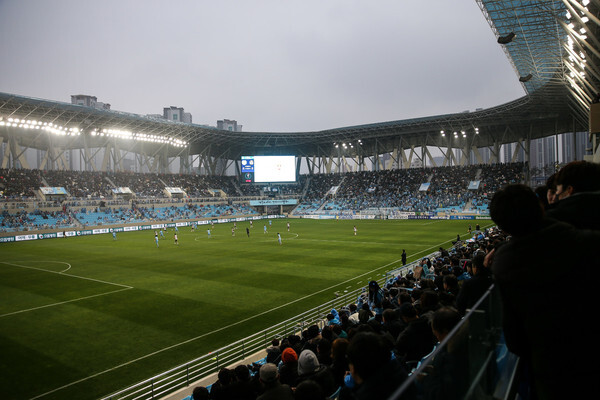hankyoreh
Links to other country sites 다른 나라 사이트 링크
[Reporter’s notebook] S. Korea’s pro sports teams suffer financial difficulties as COVID-19 situation prolongs

“It’s a really tough problem.”
This was how one pro soccer team official described the social climate of “sharing the pain” over the novel coronavirus pandemic. In particular, the official said the matter regarding athlete salaries and other issues “depends on self-motivation.” An official with the Korea Baseball Organization (KBO), which oversees pro baseball, said that sharing the pain is fine in principle, but complained that there was “no sure-fire solution.”
To be sure, South Korea’s two biggest sports -- pro soccer and pro baseball -- share a sense of alarm over the shock waves to come as a result of the coronavirus. Of the 12 teams in the pro soccer K League 1, all but Sangmu are sponsored by companies or municipal/provincial governments; most of the 10 pro baseball teams play for companies. It’s a framework where they are directly impacted by economic shocks and local governments’ financial conditions.
S. Korean clubs more shielded from financial difficulties than European counterparts
This year’s pro club budgets have already been finalized. But some fluctuations could arise if they are paid out by month or quarter. In the case of municipal and provincial governments, the ability to invest in affiliate sports teams has been constrained by the sharp rise in financial demands for basic disaster allowances. Such has been the ripple effect of the virus that the uncertainties appear likely to remain in place even if they succeed in getting through this year.
The K League is predicting lost sales of 57.5 billion won (US$47.3 million) for the 22 clubs in its two divisions if the season is completed with 27 matches instead of 38 this year. While the clubs’ costs do go down as less is spent on playing bonuses, the lost income is far greater in scale. The K League has faced a rough rote, with officials returning a portion of their pay. Players with the K League 2 team Suwon FC, which is operated with local government funds, are planning donations of 10% exclusively from players receiving annual pay of 30 million won (US$24,678) or more.
Since pro baseball involves little direct contact among players, the season could go ahead next month with no spectators. But this would mean giving up on the income from ticket sales, which make up a large portion of earnings. The situation is becoming particularly worrying for clubs with large numbers of high-earning players.
“It’s tough to talk about an across-the-board approach of athletes sharing the pain from a reduced competition schedule, since there are such large differences in terms of pay conditions and amounts,” said soccer commentator Kim Dae-gil.
Competing interests could surface as a factor when next year’s budget is decided. Athletes will have to build their bargaining strength to win over companies and local governments, while the clubs and local governments may elect to play the salary card.
The need to find a “win-win” approach rather than a “zero-sum” solution for the players and teams appears to stem from a unique aspect of the South Korean pro sports system.
By Kim Chang-keum, staff reporter
Please direct comments or questions to [english@hani.co.kr]

Editorial・opinion
![[Column] Will Seoul’s ties with Moscow really recover on their own? [Column] Will Seoul’s ties with Moscow really recover on their own?](https://flexible.img.hani.co.kr/flexible/normal/500/300/imgdb/original/2024/0513/5917155871573919.jpg) [Column] Will Seoul’s ties with Moscow really recover on their own?
[Column] Will Seoul’s ties with Moscow really recover on their own?![[Column] Samsung’s ‘lost decade’ and Lee Jae-yong’s mismatched chopsticks [Column] Samsung’s ‘lost decade’ and Lee Jae-yong’s mismatched chopsticks](https://flexible.img.hani.co.kr/flexible/normal/500/300/imgdb/original/2024/0512/3017154788490114.jpg) [Column] Samsung’s ‘lost decade’ and Lee Jae-yong’s mismatched chopsticks
[Column] Samsung’s ‘lost decade’ and Lee Jae-yong’s mismatched chopsticks- [Correspondent’s column] The real reason the US is worried about Chinese ‘overcapacity’
- [Editorial] Yoon’s gesture at communication only highlights his reluctance to change
- [Editorial] Perilous stakes of Trump’s rhetoric around US troop pullout from Korea
- [Guest essay] Preventing Korean Peninsula from becoming front line of new cold war
- [Column] The state is back — but is it in business?
- [Column] Life on our Trisolaris
- [Editorial] Penalties for airing allegations against Korea’s first lady endanger free press
- [Editorial] Yoon must halt procurement of SM-3 interceptor missiles
Most viewed articles
- 1Seoul’s plan to adopt SM-3 missiles is like wanting a sledgehammer to catch a fly
- 2[Column] Samsung’s ‘lost decade’ and Lee Jae-yong’s mismatched chopsticks
- 3[Correspondent’s column] The real reason the US is worried about Chinese ‘overcapacity’
- 4Korea poised to overtake Taiwan as world’s No. 2 chip producer by 2032
- 560% of young Koreans see no need to have kids after marriage
- 6[Editorial] Yoon’s gesture at communication only highlights his reluctance to change
- 7Yoon voices ‘trust’ in Japanese counterpart, says alliance with US won’t change
- 8Yoon rejects calls for special counsel probes into Marine’s death, first lady in long-awaited presse
- 9S.K.-Japan joint history project to be revived
- 10Former President Roh Tae-woo, mastermind of 1979 military coup, dies at 88